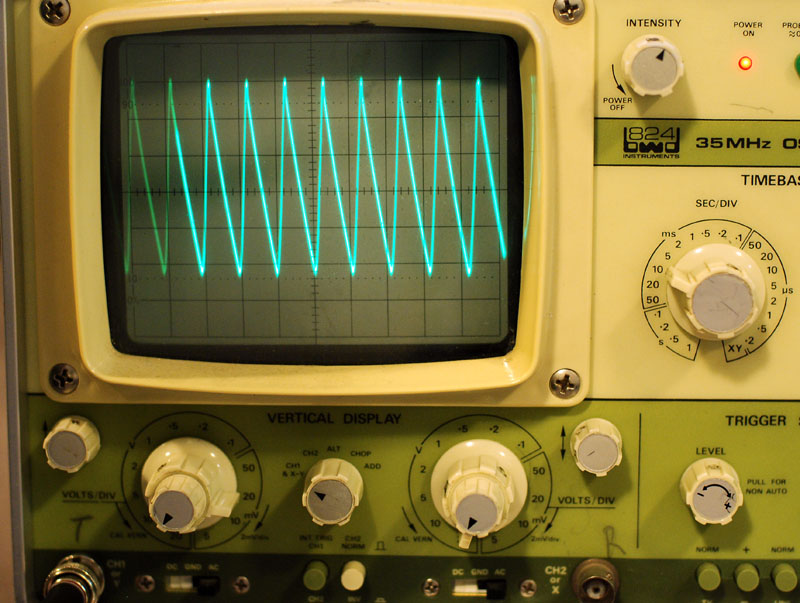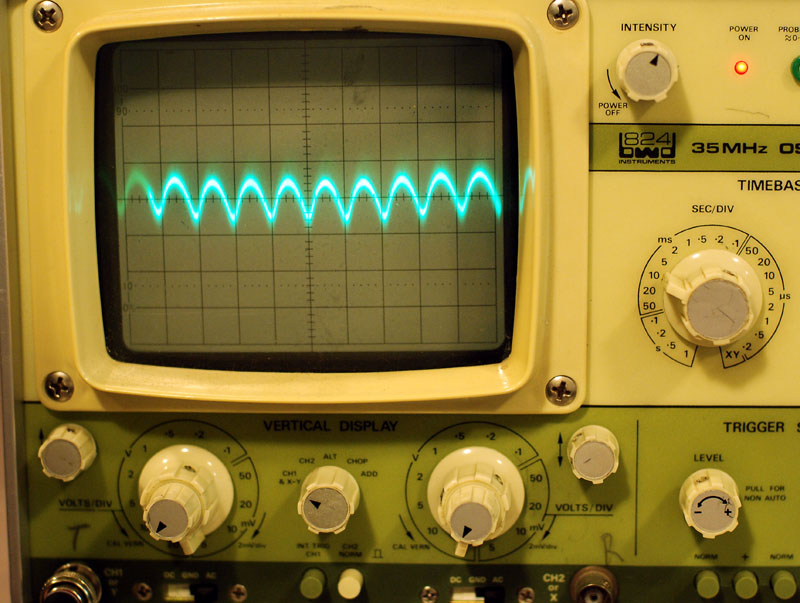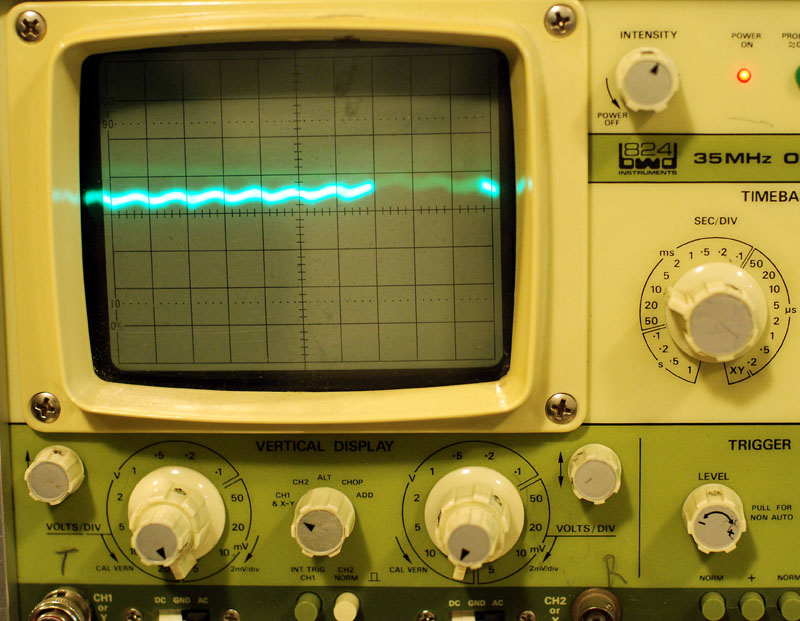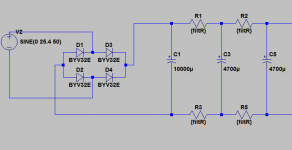Hi friends,
First of all I am not an expert in electronic design, so please be patient with me....
I have built a few months ago a new and upgraded power supply for my preamp, replacing the original P.S.
I have been using it for a few months and the improvement is really huge. The skematics of this (version 1) P.S. is herebelow:
The improvement in musicality compared to the stocked power supply is so huge, that I would like to improve further the power supply and I have been advised to add a RC network at the end of the P.S. flow. So the diagram of this version 2 would be as follow (the diagram is inspired by a dedicated article):
Compared with the version 1, (C3, C7 and C11) in the version 2 play the same role than C3 in the version 1 (they are the big capacitors decoupled by small ones).
But on the right of the diagram, we see a RC network (C15, C17 and R1/C19) that is supposed to get rid of the capacitor residual inductance (this is what is explained in the source article).
The values proposed in the article are:
C15=C17=100nF 100V
C19=680nF 100V
R1=1ohm 17W (this value is given for a power amplifier P.S., so should probably reduced to a few watts for a preamp).
My knowledge in electronic is enough to make me confortable with the version 1 (I have built it and it is a success) but I am not sure that the proposed values for the version 2 are appropriate for a preamp power supply. Could you tell me if it is OK ?
If you have any additional recommendation for improving the version 1, I will be very interested !
Thanks friends,
First of all I am not an expert in electronic design, so please be patient with me....
I have built a few months ago a new and upgraded power supply for my preamp, replacing the original P.S.
I have been using it for a few months and the improvement is really huge. The skematics of this (version 1) P.S. is herebelow:
An externally hosted image should be here but it was not working when we last tested it.
The improvement in musicality compared to the stocked power supply is so huge, that I would like to improve further the power supply and I have been advised to add a RC network at the end of the P.S. flow. So the diagram of this version 2 would be as follow (the diagram is inspired by a dedicated article):
An externally hosted image should be here but it was not working when we last tested it.
Compared with the version 1, (C3, C7 and C11) in the version 2 play the same role than C3 in the version 1 (they are the big capacitors decoupled by small ones).
But on the right of the diagram, we see a RC network (C15, C17 and R1/C19) that is supposed to get rid of the capacitor residual inductance (this is what is explained in the source article).
The values proposed in the article are:
C15=C17=100nF 100V
C19=680nF 100V
R1=1ohm 17W (this value is given for a power amplifier P.S., so should probably reduced to a few watts for a preamp).
My knowledge in electronic is enough to make me confortable with the version 1 (I have built it and it is a success) but I am not sure that the proposed values for the version 2 are appropriate for a preamp power supply. Could you tell me if it is OK ?
If you have any additional recommendation for improving the version 1, I will be very interested !
Thanks friends,
Sorry, the links should be ok herebelow (I cannot edit my first post):
Version 1:
and version 2:
Tks
Version 1:
An externally hosted image should be here but it was not working when we last tested it.
and version 2:
An externally hosted image should be here but it was not working when we last tested it.
Tks
I don't see any Resistors in there. for an example of how much effect on the ripple having a CRCRC circuit makes have a look at the below pics. edit: sorry just realised I was missing the point, and the RC was referring to the last resistor/cap in the circuit, oh well, I'll leave my irrelevant info below anyway 
the attached image (at the end) is the circuit these measurements were made against (which is the filter stage before my reg circuit). I think from memory the load was around 160mA for these shots. The R's in the circuit are 3.3ohms and the input voltage was around 18V ac RMS.
The picture below is the ripple across the 10,000uF cap, scope set on 20mV/ div

Next is the ripple across the second cap scope set at 5mV / division

last is the ripple accross the third cap, scope set at 2mV / division.

Note that there is a penalty, The higher the current draw the greater the voltage drop will be across the resistors, smaller resistors mean a smaller voltage drop and for higher currents either higher voltage (inefficient), or smaller resistors (not as effective ripple reduction) will be required. You have to choose your tradeoff. However I think the above shows the difference that adding a few resistors can make Also you need to take into account the dissipation in the resistors and size them appropriately (ie high enough wattage).
Also you need to take into account the dissipation in the resistors and size them appropriately (ie high enough wattage).
Tony.
the attached image (at the end) is the circuit these measurements were made against (which is the filter stage before my reg circuit). I think from memory the load was around 160mA for these shots. The R's in the circuit are 3.3ohms and the input voltage was around 18V ac RMS.
The picture below is the ripple across the 10,000uF cap, scope set on 20mV/ div

Next is the ripple across the second cap scope set at 5mV / division

last is the ripple accross the third cap, scope set at 2mV / division.

Note that there is a penalty, The higher the current draw the greater the voltage drop will be across the resistors, smaller resistors mean a smaller voltage drop and for higher currents either higher voltage (inefficient), or smaller resistors (not as effective ripple reduction) will be required. You have to choose your tradeoff. However I think the above shows the difference that adding a few resistors can make
Tony.
Attachments
Last edited:
Hi wintermute,
Thanks for your time...
I understand what you say, but not sure it addresses my question... it seems that your diagram with RC filters is different than the one I posted in version 2: does it mean that you replace the right part of my diagram (i.e. C15 to 20 and R1, R2) by your RC filter ?
Your diagram looks clear and efficient, but what is your opinion on the v2 diagram (I have designed the v1 not the v2) ?
Thanks for your time...
I understand what you say, but not sure it addresses my question... it seems that your diagram with RC filters is different than the one I posted in version 2: does it mean that you replace the right part of my diagram (i.e. C15 to 20 and R1, R2) by your RC filter ?
Your diagram looks clear and efficient, but what is your opinion on the v2 diagram (I have designed the v1 not the v2) ?
Yes sorry I realised that after I posted (hence the edit). As far as the second diagram is concerned I don't see a lot of point of all the extra parallel caps, IMO you will get far better value (assuming you have the voltage to spare) but also putting in small series resistance (if you are going to add extra caps), even something as low as 1/2 ohm will make a difference.
Is the output of this circuit feeding a voltage regulator? I've just looked at the values of the caps in your first diagram, I'd originally assumed that they were 22000 uF but now I'm wondering if that is 22uF Only reason is that it says they are nichicon FG's and they don't come in sizes that big (biggest is 10,000uF at 6.3V only).
With respect to the 2nd diagram, By paralleling multiple smaller caps the ESR will be reduced, but at the same the inductance will be increased. I'm not sure why each big cap would be paralleled by a small film cap, I can understand one being placed at the output to the supply, but this is something that is often debated as to whether it does more harm or good. Having one accross each big cap in the supply seems a bit strange.
The final small cap with resistor is something that caused a huge debate here on diyaudio a few years back, it was coined the snubberised supply, (which I think is a mis use of the term snubber). It was claimed to make all sorts of amazing transformations to the sound of the amplifier used on. I've not experimented with it, and don't have enough electronics knowledge to comment on it from a theoretical point of view. Certainly it wont require any significant expense to try it and you could do so on your existing v1 without adding all the extra caps of V2.
and you could do so on your existing v1 without adding all the extra caps of V2.
My circuit that I attached is overkill compared to what people normally feed a regualtor with, but my reasoning was that the lower the ripple on the input to the regulator, the easier its job is, and the lower the ripple should be on the output... this certainly seems to be the case in the sim. I need take out the 2nd and third caps and measure on the real circuit to see if there is a measurable difference in real life.
Tony.
Is the output of this circuit feeding a voltage regulator? I've just looked at the values of the caps in your first diagram, I'd originally assumed that they were 22000 uF but now I'm wondering if that is 22uF Only reason is that it says they are nichicon FG's and they don't come in sizes that big (biggest is 10,000uF at 6.3V only).
With respect to the 2nd diagram, By paralleling multiple smaller caps the ESR will be reduced, but at the same the inductance will be increased. I'm not sure why each big cap would be paralleled by a small film cap, I can understand one being placed at the output to the supply, but this is something that is often debated as to whether it does more harm or good. Having one accross each big cap in the supply seems a bit strange.
The final small cap with resistor is something that caused a huge debate here on diyaudio a few years back, it was coined the snubberised supply, (which I think is a mis use of the term snubber). It was claimed to make all sorts of amazing transformations to the sound of the amplifier used on. I've not experimented with it, and don't have enough electronics knowledge to comment on it from a theoretical point of view. Certainly it wont require any significant expense to try it
My circuit that I attached is overkill compared to what people normally feed a regualtor with, but my reasoning was that the lower the ripple on the input to the regulator, the easier its job is, and the lower the ripple should be on the output... this certainly seems to be the case in the sim. I need take out the 2nd and third caps and measure on the real circuit to see if there is a measurable difference in real life.
Tony.
I just checked the difference on the output with only 10,000uF filter and then again with only 4700uF filter cap compared to the CRCRC before the reg. Whilst the filtering makes a big difference to the pre-reg ripple, it is either not making a difference post reg, or the resolution of my scope (and the noise pickup problems I have) is not good enough for me to easily see a difference (any difference seems to be in possibly lower spikes visible when the trace intensity is increased significantly (rectifier pulses?) with the additional filtering, but I'm not sure about that.
So the circuit I posted (when followed by a regulator) is definitely overkill, but that was the original idea (go with gross overkill and see if it actually made any difference) and it was intended to be a learning experience for me
Tony.
So the circuit I posted (when followed by a regulator) is definitely overkill, but that was the original idea (go with gross overkill and see if it actually made any difference) and it was intended to be a learning experience for me
Tony.
Is the output of this circuit feeding a voltage regulator? I've just looked at the values of the caps in your first diagram, I'd originally assumed that they were 22000 uF but now I'm wondering if that is 22uF Only reason is that it says they are nichicon FG's and they don't come in sizes that big (biggest is 10,000uF at 6.3V only).
You are right: in my original design (version 1) they were 22kµF.
True: for my new design, I have chosen to reduce the ESR: I will see (ear) if it is better ...With respect to the 2nd diagram, By paralleling multiple smaller caps the ESR will be reduced, but at the same the inductance will be increased.
Not false, a unique small capacitor after the big ones is enough.I'm not sure why each big cap would be paralleled by a small film cap, I can understand one being placed at the output to the supply, but this is something that is often debated as to whether it does more harm or good. Having one accross each big cap in the supply seems a bit strange.
The final small cap with resistor is something that caused a huge debate here on diyaudio a few years back, it was coined the snubberised supply, (which I think is a mis use of the term snubber). It was claimed to make all sorts of amazing transformations to the sound of the amplifier used on. I've not experimented with it, and don't have enough electronics knowledge to comment on it from a theoretical point of view.
This is THE question I have... some people says it brings a benefit, some other says "no" like the debate you talk about. Like you, I do not have enough electronic knowledge to have a firm position on this point...
I am looking for somebody having a lot of expertise in P.S. building and designing, but it seems not easy to find !...
If somebody has some ideas on how to improve the v2 design without this additional right part, I am interested...
I send you PM to continue this discussion ...
Nounours,
Don't go higher than 10000uF on the caps directly connected to the rectifier bridge.
More will put too much stress on the transformer and rectifiers. (Horowitz page 330)
If you want lower ripple add extra RC section(s) as in Wintermute's schematic.
I agree on your findings about musicality. Did not dare to post it

Don't go higher than 10000uF on the caps directly connected to the rectifier bridge.
More will put too much stress on the transformer and rectifiers. (Horowitz page 330)
If you want lower ripple add extra RC section(s) as in Wintermute's schematic.
I agree on your findings about musicality. Did not dare to post it
Last edited:
The 'snubber' network may reduce resonance problems caused by the small capacitors bypassing the big ones. The proper place for a bypass is not at the PSU cap, but on the amp circuit board. The resistance of the cabling then helps damp any electrical resonance between the capacitance of the bypass and the inductance of the big electrolytic. Uing high ESR caps will also damp the resonance.
BTW putting identical caps in parallel reduces their inductance, not increases it. It also reduces ESR, which may make resonance worse.
BTW putting identical caps in parallel reduces their inductance, not increases it. It also reduces ESR, which may make resonance worse.
Hi friends,
Sorry for my late reply, but I had to stay at the hospital for a serious surgery and I just feel good enough to post again...
My current P.S. (version 1) uses 2x22.000µF, so I keep in mind to use 10.000µF max for the next version... (thanks for the advise)
what does this mean ? does it refer to a dedicated post ?
Let's back to the diagram suggested :
I understand what you explain but I do not have enough knowledge to properly calculate the resistors value nor the transformer output voltage (provided that the resistors will generate a voltage loss).
Is there a "common" value or a way to calculate them ? : I would avoid to buy parts (particularly the transformer...) and see that the value are not OK... In addition, it seems that you are not totally sure that adding the CRC circuitry would improve the sound ?
Thanks,
N.
Sorry for my late reply, but I had to stay at the hospital for a serious surgery and I just feel good enough to post again...
Nounours,
Don't go higher than 10000uF on the caps directly connected to the rectifier bridge.
More will put too much stress on the transformer and rectifiers.
My current P.S. (version 1) uses 2x22.000µF, so I keep in mind to use 10.000µF max for the next version... (thanks for the advise)
Horowitz page 330
what does this mean ? does it refer to a dedicated post ?
I see, I will.If you want lower ripple add extra RC section(s) as in Wintermute's schematic.
Let's back to the diagram suggested :
An externally hosted image should be here but it was not working when we last tested it.
I understand what you explain but I do not have enough knowledge to properly calculate the resistors value nor the transformer output voltage (provided that the resistors will generate a voltage loss).
Is there a "common" value or a way to calculate them ? : I would avoid to buy parts (particularly the transformer...) and see that the value are not OK... In addition, it seems that you are not totally sure that adding the CRC circuitry would improve the sound ?
Thanks,
N.
BTW putting identical caps in parallel reduces their inductance, not increases it. It also reduces ESR, which may make resonance worse.
Woops! for some reason I was thinking that inductors behaved like caps when paralleled
Nounours, do you know the actual current draw of your preamp, if you do (or can measure it) then just plug in to ohms law as given by DF96 to get the voltage drop across your chosen resistor value.
The resistor value I was using was 3.3 ohms. This is fine for my circuit which I don't expect to draw more than about 180mA.
Tony.
Hi friends,
Sorry for my late reply, but I had to stay at the hospital for a serious surgery and I just feel good enough to post again...
My current P.S. (version 1) uses 2x22.000µF, so I keep in mind to use 10.000µF max for the next version... (thanks for the advise)
what does this mean ? does it refer to a dedicated post ?
I see, I will.
Let's back to the diagram suggested :
An externally hosted image should be here but it was not working when we last tested it.
I understand what you explain but I do not have enough knowledge to properly calculate the resistors value nor the transformer output voltage (provided that the resistors will generate a voltage loss).
Is there a "common" value or a way to calculate them ? : I would avoid to buy parts (particularly the transformer...) and see that the value are not OK... In addition, it seems that you are not totally sure that adding the CRC circuitry would improve the sound ?
Thanks,
N.
Hi N, I wish you good recovery from the surgery.
The trick is I am using only CRC filtering in my power supply; no voltage regulators or shunt regulators. Many forum members will think I am crazy but my ears don't lie.....
As already explained you can calculate the voltage drop across the resistor by Ohm' s law, knowing the current consumption of your circuit.
Welcome back!
Hi N, I wish you good recovery from the surgery.
Thanks and thanks ! I recover slowly but (very) surely !
do you know the actual current draw of your preamp, if you do (or can measure it) then just plug in to ohms law as given by DF96 to get the voltage drop across your chosen resistor value.
Actually I don't -it is a Threshold Fet-10HE preamp- but I could measure it (being cautious because I have so much upgraded it that it is as good as "formula one" preamp and a precious device for me...).
I will spend more time on this subject in a few weeks, because for the time being I have a Conrad-Johnson Premier Ten preamp to upgrade (I do not like tubes, and it is far from my preamp, but I will try to improve it...) and more important, I am learning how to pair Mosfets, using the Nelson article "Practical Mosfet testing for Audio"...
So you will probably soon see another post from me looking for some advises on this approach...
Thanks friends (I will go back to this Power Supply optimization),
N
Quote:
With respect to the 2nd diagram, By paralleling multiple smaller caps the ESR will be reduced, but at the same the inductance will be increased.
wintermute, I think the inductance should be reduced as well (at least the parasitic inductance of the caps), there may be additional inductance due to the wiring and PCB though.
paralleling caps is a good "trick" to do better wtih so-so caps, but you get to a point of diminishing return with really good caps, because of the stray resistance and inductance of the wiring...
just my two cents
With respect to the 2nd diagram, By paralleling multiple smaller caps the ESR will be reduced, but at the same the inductance will be increased.
wintermute, I think the inductance should be reduced as well (at least the parasitic inductance of the caps), there may be additional inductance due to the wiring and PCB though.
paralleling caps is a good "trick" to do better wtih so-so caps, but you get to a point of diminishing return with really good caps, because of the stray resistance and inductance of the wiring...
just my two cents
- Status
- This old topic is closed. If you want to reopen this topic, contact a moderator using the "Report Post" button.
- Home
- Amplifiers
- Power Supplies
- Need help on RC filter for power supply

